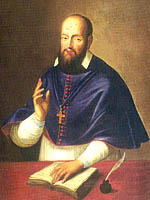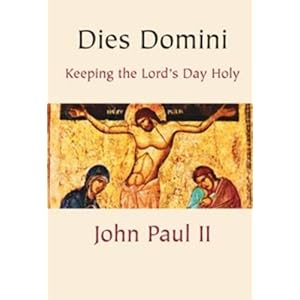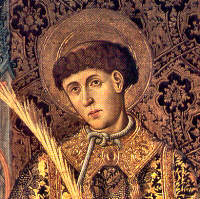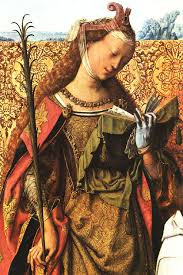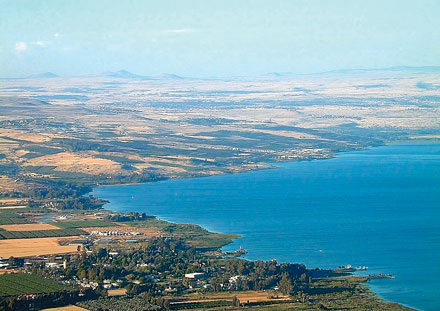
"In his life the supernatural became the natural and the extraordinary the ordinary." So spoke Pope Pius XI of the beloved Don Bosco, renowned for his educational pioneering and his affectionate care for the fatherless. Born Giovanni Melchior Bosco in 1815, the future saint was the youngest son of a peasant farmer in the hamlet of Becchi, in the Piedmont district of north Italy. He lost his father at the age of two and was brought up by a devoted and industrious mother, Margaret Bosco, who had a hard struggle maintaining the home and the three children, all of them boys. A dream that little Giovanni had at the age of nine revealed to him his vocation. He seemed to be surrounded by a mob of fighting and swearing children whom he tried in vain to pacify, at first by arguments and then by hitting them. Suddenly there appeared a mysterious woman who said: "Softly, softly . . . if you wish to win them! Take your shepherd's staff and lead them to pasture." Even as she spoke, the children were transformed first into wild beasts and then into gentle lambs. From that time on, the boy thought, it was his clear duty to lead and help other boys.
He began with those of his own village, teaching them the Catechism and bringing them to church. As an inducement, he would amuse them first with acrobatic and conjuring tricks, at which he became very clever. One Sunday morning when an itinerant juggler and gymnast was holding the children spellbound by his performance, young John challenged him to a competition and beat him at his own tricks. Then he marched off to church, followed by his admiring audience. It was more or less by chance that this talented boy learned to read. He was staying with an aunt who was servant to the priest, and when the priest was told of John's ambition, he taught him gladly. But John didn't want to stop with reading and writing; he wished to study for the priesthood. Many difficulties had to be overcome before he could even begin his preliminary studies. When, at sixteen, he entered the seminary at Chieri, he was so poor that money for his maintenance and his clothes had to be supplied by charity. The village mayor contributed a hat, one friendly person gave him a cloak, and another a pair of shoes. People were eager to help a boy who was himself so eager and ambitious. After his ordination as deacon, he attended the theological school at nearby Turin, finding time to continue his volunteer work with homeless or neglected boys. Having won the approbation of his superiors for what he was doing, he began to gather around him regularly on Sunday afternoons a band of these waifs and young apprentices.
After taking Holy Orders, his first appointment was assistant chaplain of a home for girls, founded by the Marchesa Barolo, a wealthy and philanthropic woman. This post left Don Bosco free on Sundays to devote himself to his group of boys. He set up for them a sort of combined Sunday School and recreation center on grounds belonging to the Marchesa, which he called "the festive Oratory." But the Marchesa quickly withdrew her permission, because the boys were, naturally, noisy and unruly, and sometimes even made so bold as to pick the flowers in the garden. For more than a year the group was regarded as a nuisance and sent from pillar to post. No property owner was able to put up with them for long. When at last Don Bosco was able to hire an old shed as a meeting place, and the future seemed promising, the Marchesa delivered herself of an ultimatum. He must choose between giving up the boys—who now numbered several hundred—or resigning his post at the girl's orphanage. Don Bosco promptly resigned, to devote himself wholly to the boys.
In the midst of these anxieties, he was prostrated by a severe attack of pneumonia that came near ending his life. As soon as he had recovered, he went to live in some poor rooms adjoining a new Oratory, or gathering place, with his mother as housekeeper. For ten years this good woman served as his adjutant and loyal helper, extending her motherly care over all the waifs and strays her son brought to her. Don Bosco now applied himself to consolidating his work and planning for the years to come. A night school which had been opened the previous year took shape, and as the Oratory was soon overcrowded, he opened two more youth centers in other parts of Turin. About the same time he began housing a few destitute boys. His next step was to build for his flock a small church which he placed under the patronage of his favorite saint, Francis de Sales. With that completed, he started to build a home for his steadily growing family. No one knew just how he managed to raise the money for these various projects, but his natural persuasiveness had much to do with it.
Those enrolled as boarders in the school were of two sorts: young apprentices and craftsmen, and other youths of more than average intelligence in whom Don Bosco discerned future helpers, with, possibly, vocations to the priesthood. At first they attended classes outside, but, as more teachers were enlisted, academic and technical courses were given at the house. By 1856 a hundred and fifty boys were in residence; there were four workshops, including a printing shop, and four Latin classes, with ten young priests as instructors; all this in addition to the oratories with their five hundred children. He cultivated in all of them a taste for music, and he was a believer in the therapeutic value of play. Don Bosco's understanding of young people, their needs, and their dreams, gave him great influence. He could manage them without punishment. "I do not remember to have used formal punishment," he wrote, "and with God's grace I have always obtained-and from apparently hopeless children-not alone what duty exacted but what my wish simply expressed." With an approach that seems quite modern, he planned programs that combined play, song, study, prayer, and manual work. He knew that straight academic learning was not enough. "Knowledge gives more power in the exercise of good or evil," he said, "but alone it is an indifferent weapon, lacking guidance."
Don Bosco's outgoing personality made him popular as a preacher, and there were many demands on his time to speak to various congregations. As a third form of activity, in the few hours that remained to him, he wrote useful and popular books for boys. In that day there was almost no attractive reading matter written especially for young people, and Don Bosco set himself to fill this need. He wrote stories based on history, and sometimes popular treatises on the faith. Often he toiled far into the night, until, in later life, his failing eyesight compelled him to give up writing.
A plan for some sort of religious order, to carry on the work when he had passed away, had long been in Don Bosco's mind, and at last he felt he had the strong nucleus of helpers that was required. "On the night of January 26, 1854, we were assembled in Don Bosco's room," writes one of the men present. "Besides Don Bosco, there were Cagliero, Rocchetti, Artiglia, and Rua. It was suggested that with God's help we should enter upon a period of practical works of charity to help our neighbors. At the close of the period, we might bind ourselves by a promise which could subsequently be transformed into a vow. From that evening, the name of Salesian was given to all who embarked on that form of apostolate." The name of course honored the great bishop of Geneva, St. Francis de Sales. It was not a propitious time for launching a new order, for in all its history Piedmont had never been so anti-clerical. The Jesuits and the Sisters of the Sacred Heart had been expelled, many convents suppressed, and laws were being passed curtailing the rights of religious orders. The statesman Urbano Rattazzi, one of those most responsible for the anti-clerical legislation, was deeply interested in popular education. As a resident of Turin, Rattazzi was familiar with Father John's activities, and, on meeting him by chance one day, urged him to found a society to further his valuable work, promising the support of the government.
The project grew, and in 1858 John went to Rome, taking with him the rules of the institution. From Pope Pius IX he received preliminary approbation. Sixteen years later he obtained full sanction, together with permission to present candidates for Holy Orders. The new society grew rapidly. Within five years there were thirty-nine Salesians; at the time of the founder's death there were eight hundred, and by 1929 the number had increased to about eight thousand. One of Father John's dreams was realized when he sent his first missionaries to the bleak and faraway land of Patagonia; other areas of South America were soon the scene of missionary endeavor. He lived to see twenty-six houses started in the New World and thirty-eight in the Old.
His next great work was the foundation in 1862 of an order of women to do for poor girls what the Salesians were doing for boys. The original group consisted of twenty-seven young women to whom he gave the name of Daughters of St. Mary Auxiliatrix, the Helper. The organization now numbers many thousands, with elementary schools in Italy, Brazil, and Argentina. To supplement the work of these two congregations, Father John organized his outside lay helpers into a new kind of Third Order, which he called Salesian Cooperators. They were men and women of all classes who pledged themselves to assist in practical ways the educational labors of the Salesians.
Any account of the life of this saint would be incomplete without some mention of his achievements as a builder of churches. His first little church of St. Francis de Sales soon proved inadequate, and he undertook the construction of a much larger building. This he finished in 1868, dedicating it to St. Mary the Helper. Later he found means to put up another spacious and much-needed church in a poor quarter of Turin, and this he placed under the patronage of St. John the Evangelist. But the immense effort of money-raising had left Don Bosco weary and depleted. He was not allowed time to recover his strength before another task was put before him. During the last years of Pope Pius IX, a project had been formed of building at Rome a church in honor of the Sacred Heart of Jesus, and Pius himself had donated money to buy the site. His successor, Leo XIII, was eager for the work to be carried forward, but there was difficulty in raising funds. It was suggested to the Pope that this was something that Don Bosco did better than anyone else, and when he was asked to undertake it, he accepted the challenge.
After obtaining a considerable sum in Italy, Don Bosco went to France, where devotion to the cult of the Sacred Heart was particularly intense at this time. He was successful in his appeals, money came flowing in, and the early completion of the church was assured. As the day appointed for its consecration drew near, he was sometimes heard to murmur that if there were any delay, he would not live to witness it. Two years before the doctors had said that this generous-hearted man had worn himself out and that complete retirement offered the only chance of prolonging his life. Don Bosco had the joy of living a few months beyond the consecration of the church, which took place on May 14, 1887. He said one Mass before the new high altar.
Later in the year it became plain that his days were numbered; he gradually weakened, and on the morning of January 31, 1888, he died in his home city of Turin. Forty thousand persons came to the church to do honor to Don Bosco, and the entire city turned out as his remains were borne to their resting place. His memory was cherished and his work carried on by his followers. Not many years had elapsed before a movement was begun for his beatification. He was declared Venerable by Pope Pius X in 1907, beatified by Pius XI in 1929, and canonized by him in 1934. Don Bosco exemplified a new trend in the treatment of children, anticipating in some respects the practices of modern psychologists. Intuitively he knew that the loving care and attention of a wise, interested adult was essential to the healthy growth of every child, and he gave his very best to those children who had the least.
(taken from EWTN)
O God, who raised up the Priest Saint John Bosco as a father and teacher of the young, grant we pray, that, aflame with the same fire of love, we may seek out souls and serve you alone. Through our Lord.











